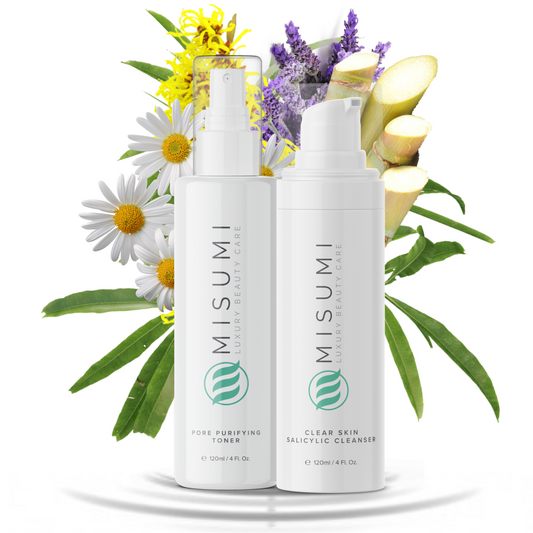Rosacea is a skin condition that can be quite hard to diagnose, let alone deal with. However, with a couple of tips and tricks, you too can manage this pesky skin condition. In this article, you will find out what are its symptoms, how it’s diagnosed, and you’ll read 6 life-saving skincare tips that will allow you to cope with it..
Now let’s get started by explaining which symptoms you should look out for.
What Is Rosacea?
Rosacea is a chronic and inflammatory skin disorder that’s characterized by multiple symptoms. Millions of people around the world are affected by it. Since its symptoms are so peculiar, it’s easy to misdiagnose, making the rosacea treatment process hard and prolonged.
Currently, there isn’t a specific test for rosacea. What doctors often do is examine the symptoms closely and do a physical examination of your skin up close. Due to the similarity of the symptoms with other skin conditions, sometimes doctors do other tests in order to rule out any other diagnoses such as acne or eczema.
Symptoms of Rosacea
One of the most obvious symptoms of rosacea is exacerbated redness on the cheeks and T-zone area. Often this redness covers the neck, hands, and ear area. Not only is redness present, but it can be accompanied by swelling in those places as well. There are a couple of other symptoms you should be on the lookout for such as:
- a burning sensation
- eye vision problems
- dry skin patches
- swelling in the nose
- enlarged pores
The symptoms of rosacea are not consistent. They might appear one day and disappear the next. This inconsistency causes many problems as far as diagnosis is concerned. If you do recognize some of them, make sure you schedule an appointment with a certified dermatologist in order to get your skin checked out.
Causes of Rosacea

There are many reasons as to why this chronic skin condition might appear. Unfortunately, dermatologists don’t have a single answer and they don’t always know the causes of rosacea. There are a couple of things that might contribute to the appearance of rosacea, such as:
Genetics
Many people aren’t aware that rosacea runs in families and it can be passed on through our genes. This is one of the reasons why dermatologists often ask patients for their medical history before coming to a definite diagnosis. If there is someone in your immediate family that has suffered from rosacea, chances are it can also affect you. This doesn’t guarantee that your diagnosis will be the same, so doctors need to take a look at other variants before coming to a definite conclusion.
Bacteria
Just like the skin condition acne, which is caused by bacteria called P.acnes, rosacea is caused by a bacteria called H.pylori which can be found in our gut.
You might be thinking: what’s the correlation between a type of bacteria that’s found in our gut and our skin? Well, this bacteria, in particular, is known to raise the hormone called gastrin that produces redness on our skin.
Mites
On a similar note, mites can also cause rosacea. Disgustingly enough, these insects live on our skin, but don’t cause any adverse effects most of the time. However, if you have a higher amount of mites than the average person, it could cause some trouble in regards to your skin.
Enlarged Blood Vessels
If you suffer from chronic redness, it could be due to enlarged blood vessels on your face. This condition is often worsened by untreated sun damage or a persistent lack of sun protection.
Are You More Prone to Getting Rosacea?

There is a group of people that’s more prone to suffering from this skin condition than the rest. Statistics show that people who have lighter skin, hair and eye color are more prone to getting rosacea than the rest. On top of that, women are more prone to getting rosacea than men are, especially between the ages of 30 and 60.
Similarly, people who have suffered from another skin condition in the past (such as acne) are more prone to getting rosacea. If you’re the type of person who blushes easily, then you’re also more likely to suffer from rosacea. And last but not least, smokers are more likely to get this condition as well.
Rosacea Phases
In terms of the actual condition itself, it’s usually manifested through a couple of phases.
Pre-rosacea phase: this phase is preceded by most of the other symptoms and is characterized by skin flushing. Afterward, prominent redness and enlargement of blood vessels can be seen.
Vascular Rosacea: this phase is characterized by a worsening of existing symptoms (the one we mentioned previously in this article). The skin becomes more prone to irritation and, in turn, more sensitive. The t-zone is often covered with redness and sometimes even swollen.
Inflammation phase: the final stage of rosacea, this particular stage is characterized by large bumps or blister-like spots on the affected areas.
Rosacea Triggers
Just like any other chronic disease, rosacea also has certain triggers. If you’re diagnosed with rosacea at some point, here are the things to look out for in terms of triggers for the skin.

Certain food, such as extremely hot beverages and very spicy food can be a big trigger for rosacea patients. Try your best to avoid ingesting these kinds of food if you have rosacea.
Being in stressful situations or suffering from chronic stress. Stress is an integral part of life and it can’t always be avoided, but there are a couple of ways you can train yourself to manage stress to the best of your abilities. These methods are varied, so you can pick and choose ones that best fit your lifestyle.
Practicing meditation for a couple of minutes per day is known to reduce stress and keep us mindful and happier. On a similar note, taking up yoga practice or any other physical activity for that matter is one of the best ways to reduce stress and keep those endorphins running. Journaling and reading are also proven to have a similar effect on those who are chronically stressed. Lowering your stress levels should be a priority, not just in regards to rosacea, but also your overall health.

Alcohol is one of the best-known triggers for many skin disorders, not just for rosacea. This is not to say that you should avoid alcohol altogether, but just be wary of the effect that it has on your body. Not all alcohol is created equal, so stronger beverages such as whiskey or vodka can lead to stronger facial flushes than if you were to consume a glass of red wine, for instance.
The sun is another trigger, but luckily one you can avoid. Never leave the house without applying some kind of sun protection.
Certain medications like steroid or high blood pressure medicine can also trigger rosacea.
Avoiding your triggers is a good starting point, but certain things on this list can’t be avoided, such as taking your medication or not stressing out all the time. As far as the things you can control are concerned, do your best to avoid them.
Treatment Options for Rosacea
We’ve discussed all the symptoms, all the stages and all the triggers for rosacea, and now it’s time to move on to the treatment options that are available as of today.
Although, technically, there isn’t a cure for rosacea, there are certain medications and treatment options that reduce most of the symptoms which come with the condition. Here are the most commonly used treatment options for rosacea.
Medications for Rosacea

Antibiotics: perhaps the most commonly used oral medication for treating rosacea, antibiotics have been prescribed to patients for decades on end. Antibiotics are also used for other skin conditions, such as acne. The most commonly used form of antibiotics for this purpose is tetracycline. Doxycycline is also prescribed, especially low dose doxycycline which isn’t as strong on the body as the rest of them. It takes from one up to three months of treatment for patients to see any noticeable results and antibiotics are mostly prescribed to patients with severe rosacea.
Antibiotics don’t treat the redness but they treat the lesions that are caused by rosacea. If your doctor finds that you do need antibiotics for your rosacea diagnosis, you will get it prescribed in conjunction with other topical treatments, maybe even topical antibiotics.
The thing about antibiotics is that your body can develop resistance to them. This condition called antibiotic resistance is a major concern in the medical community nowadays. On top of them no longer being useful for patients, your gut can also suffer from taking too many antibiotics without any probiotics.
These are some of the reasons why you should never take antibiotics by yourself, without them being prescribed to you by a certified doctor or dermatologist. Always take them with probiotics and never stop in the middle of your treatment or cut your treatment short, no matter the results you’ve seen thus far.

Retinoids (Isotretinoin/ Accutane/ Roaccutane): if your diagnosis doesn’t respond to conventional antibiotic treatment, your doctor might prescribe retinoids to you. Retinoids are strong oral medications which are derivatives of vitamin A. Even though this particular medication has a high success rate, it comes with a myriad of side-effects that have to be taken seriously by patients.
The most common side-effects include dry skin, eye vision problems, dry lips, joint pain, and hair loss. If any of these side-effects linger on for long periods of time, or if you start to notice any other side-effects which are connected to mental health, contact your doctor immediately. Depending on the severity of your condition, your doctor might prescribe a low dose of retinoids or a slightly higher one.
Just like antibiotics, retinoids work mostly on the bumps caused by rosacea, so it won’t be a useful treatment as far as redness is concerned. For battling the redness, you might be prescribed a topical treatment.
It’s extremely important to note that this drug mustn’t be used during pregnancy or breastfeeding. This is why some institutions will require you to sign an agreement declaring that you won’t become pregnant during the treatment.
Topical Medication

Topical medication is also a powerful way to treat rosacea symptoms, with fewer side-effects.
Brimonidine is an effective topical medication option that is applied to the skin as a gel. It’s very useful for rosacea patients because it constricts blood vessels, which, as we’ve covered in this article, is one of the most prominent symptoms of rosacea. This medication is usually applied about twice a day, morning and night.
Metronidazole is another cream that can help with rosacea. The good thing about this cream is that it’s not only used to treat the breakouts which are a side-effect of this skin condition, but it can also treat the redness which is very hard to deal with. Metronidazole can be a little tricky to apply for the first time since it’s often accompanied by a burning sensation, but it usually goes away on its own once the skin has adapted to it.
Azelaic acid is a specific skin treatment that’s also applied to the skin topically twice a day. It works by lightening the skin and combating the notorious redness associated with rosacea. Azelaic acid comes with a couple of side-effects on its own, so be prepared for some burning and tingling sensations once you apply this cream for the first time. As soon as your skin gets used to the treatment these sensations are supposed to go away. If they don’t, make sure you contact your doctor and inform them about the persistent side-effects of this topical treatment.
Sulfur is exceptionally effective in dealing with a couple of skin conditions. In regards to rosacea, it can help with both the redness and the breakouts, so it’s very useful as a treatment option. The best part is – there are little to no side-effects associated with rosacea, so even if you have sensitive skin it’s not likely to cause any troubles.
We’ve talked about oral retinoids as treatment options, but topical retinoids can be just as effective. They have the same effect as when used as oral medicine, and if you use both treatment options simultaneously you’ll have a better chance of winning the battle against rosacea. Other than helping with rosacea, topical retinoids can also help with regular acne and premature signs of aging. This cream is usually applied at night, and using sun protection while you’re on it is a must!
Other Treatment Options

There are some other treatment options that can be done at most dermatology offices. If you have some extra money to spare, consider starting laser therapy. Laser or light therapy can be used to combat the redness and the acne, all at once. Even though it’s quite expensive, it’s proven to be effective for most patients suffering from rosacea.
However, one treatment isn’t enough, so you do have to make a few treatments back-to-back in order to see major results. Make sure the doctor who’s performing the treatments is qualified and experienced in this type of treatment.
Life-saving Tips for Battling with Rosacea
When it comes to your skincare routine, it’s imperative that you pay special attention to the products you use on your skin. On top of that, you’ll also want to pay attention to your lifestyle habits and choices, since, as we discussed, they can also aggravate rosacea.
Wash Your Skin with a Gentle Cleanser
Probably one of the most important choices we have to make in regards to skincare is which cleanser we’ll use on our skin. For rosacea patients, it’s recommended that you keep it simple and gentle. Don’t use cleansers that have too many chemicals inside since they can trigger symptoms.
Another thing to pay attention to is how often you’re washing your face. By over-washing your face you risk stripping away the natural oils from your skin, thus leaving your skin dry and irritated. In order to avoid this, apply the golden rule: wash your face morning and night with a gentle cleanser that is considered to be rosacea-friendly.
Follow it up with a Quality Moisturizer
What’s the use of cleansing your skin properly if you aren’t following it up with a quality moisturizer? Moisturizing is crucial for people who suffer from rosacea, no matter if your skin is dry or oily. It can restore the balance in your skin and help with any symptoms of this condition, like dry patches and peeling.
Just like when you’re choosing which cleanser to use, you should also pay attention to your moisturizer. It has to be rosacea-friendly and ideally, it won’t contain any harsh chemicals which can exacerbate any ongoing symptoms you may have such as alcohol, fragrance, glycolic acid, lactic acid, and camphor. Pay attention to how your skin reacts to certain ingredients and don’t be afraid to cut them out if you have to.
Always Wear Sun Protection

Protecting our skin from the sun is important for everyone, but it’s especially important when it comes to people who are suffering from rosacea. Even if you don’t expose your skin to the sun directly, if you’re planning on leaving the house, you should always wear at least SPF 30. Despite of the weather report, make it a habit of doing so. The sun can penetrate through the clouds, so cloudy weather also requires you to wear SPF.
Similarly to choosing other skincare products, you should also pay attention to the ingredients of the sun protection of your choice and avoid the common triggers mentioned above.
Always Do a Patch Test
Patch tests are really important when trying out new products. Apply a small product on your face and wait a couple of days for a reaction. If your skin isn’t irritated, continue to use it on your entire face.
Whatever You Do, Be Gentle with Your Skin

Harsh motions and ingredients can irritate rosacea further. Avoid being too rough on your skin and using harsh products or sponges. Never use products that aren’t prescribed to you by your doctor.
Simplify your skincare routine and your skin will thank you for it.
Find a Good Support System
Rosacea can be very tough to deal with, both physically and emotionally, which is why it’s important for you to surround yourself with people who are supportive and caring. Never feel ashamed of your journey. Remember – millions of people have suffered from rosacea at some point.
In order for you to have the safest and quickest recovery possible, make sure you consult with a doctor first. Going to therapy can be of help in terms of your mental health during the recovery process.
Final Thoughts
Rosacea is a common skin disorder that is characterized by symptoms such as redness, swelling, enlarged pores, and acne-like breakouts. Even though it doesn’t have a set cure as of today, there are some treatment options your doctor will put you on such as oral or topical medication and creams which help with the symptoms.
Making a few changes in your lifestyle and habits, as well as paying attention to your skincare routine is what’s required of you in order to have a pain-free treatment process. In addition, avoiding certain known triggers is also recommended.
Dealing with rosacea can be an exhausting process, however, by following the advice of a certified medical professional, you can have a safe and quick recovery and feel better in no time.
This information is meant to supplement, not replace advice from your doctor or healthcare provider and is not meant to cover all possible uses, precautions, interactions or adverse effects. This information may not fit your specific health circumstances, and its goal is to offer a general view of the subject. In case you are suffering from a severe case of acne, you should consult with a dermatologist or a certified medical professional.








